Optimal Meshing Degree Performance Analysis in a mmWave FWA 5G Network Deployment
Abstract
1. Introduction
- The presentation of the quantifiable performance improvements to be gained when employing increasingly dense next-generation meshed backhaul networks;
- The delineation of the performance trade-offs that must be considered in such a 5G FWA meshed network in terms of throughput vs. stability.
2. Literature Review
2.1. 5G Non-Public Networks and Fixed Wireless Access Deployments
2.1.1. FWA Trials
2.1.2. Performance Analysis and Optimisation in 5G NPN FWA Backhaul
2.2. WMN Node Placement and Routing
2.2.1. Node Placement and Optimisation
2.2.2. Topology Optimisation
2.2.3. Wireless Mesh Routing
3. Problem Description
3.1. Liverpool 5G Deployment
3.2. Meshed FWA Deployment
3.2.1. Phoenix Road Deployment
3.2.2. WMN Optimisation Constraints
- All nodes (MG and MR) in the deployment are fixed and cannot move.
- Each node has a fixed degree of interconnectedness with the surrounding nodes, which are predetermined in advance based on LOS restrictions.
- However, we assume that nodes may have multiple interfaces that are not always active based on the clustering configuration.
- The deployment uses 802.11ad 60 GHz links that are optimised using beamforming to provide point-to-point connectivity as provided by the vendor’s equipment [44].
- The deployment is configured such that neighbouring links use separate channels so that interference is not a realistic consideration; for example, link 18–19 will not interfere with link 19–20. The considered channels are centred at 60.48 GHz and 62.64 GHz.
- The links’ performance is bounded by the constraints we have modelled through our ongoing network-modelling research, which is reported in [21].
- For the purposes of our experiment, new links may be added between nodes where physical LOS is not currently possible. In each case, we assume the link will exhibit similar properties based on technology and the link distance in a street canyon path loss model [45]. This model allows us to represent the typical urban scenario in Liverpool: a city street with pedestrian sidewalks alongside long tall buildings. In the street canyon channel model, there are two dominant reflected rays, in addition to the direct link, that are considered: the ground-reflected ray and the wall-reflected ray. Furthermore, the random components that represent reflection scattering are considered in the link simulation. The reflection from the distant walls and second-order reflection are taken into account as random components.
4. Meshed Network Deployments
5. Experimental Simulation and Results
- Average Latency—This is defined as the average time from when the packet transmission departs from the source node to when the data packet is successfully received by the POP. Latency is set to 1 ms per hop. This value is specified based on real-life measurements.
- Packet Error Rate (PER)—This is defined as the ratio between the erroneous data packets received at the POP to the total transmitted data packets.
- Packet Delivery Fraction (PDF)—This is defined as the ratio of the number of data packets correctly received by the POP to the total number of data packets generated by the source.
- Throughput—This is defined as the total amount of information received at the POP divided by the total session time in bits per second (bps).
- Data Rate—This is defined as the total amount of received information at the POP, which is also represented in bps.
5.1. Comparative Performance Analysis of Topologies in Terms of Latency
5.2. Comparative Performance Analysis of Topologies in Terms of Packet Error Rate (PER)
5.3. Comparative Performance Analysis of Topologies in Terms of Packet Delivery Fraction (PDF)
5.4. Comparative Performance Analysis of Topologies in Terms of Throughput
5.5. Comparative Performance Analysis of Topologies in Terms of Data Rate
6. Conclusions
Author Contributions
Funding
Data Availability Statement
Conflicts of Interest
References
- Chowdhury, M.Z.; Shahjalal, M.; Ahmed, S.; Jang, Y.M. 6G Wireless Communication Systems: Applications, Requirements, Technologies, Challenges, and Research Directions. IEEE Open J. Commun. Soc. 2020, 1, 957–975. [Google Scholar] [CrossRef]
- Tripathi, S.; Sabu, N.V.; Gupta, A.K.; Dhillon, H.S. Millimeter-Wave and Terahertz Spectrum for 6G Wireless. In 6G Mobile Wireless Networks; Computer Communications and Networks; Springer: Berlin/Heidelberg, Germany, 2021. [Google Scholar] [CrossRef]
- Legg, P.; McConnell, R. Meshed Backhauling of Small Cells Using IEEE802.11ad at 60 GHz. In Proceedings of the European Conference on Networks and Communications (EuCNC), Ljubljana, Slovenia, 18–21 June 2018; pp. 393–397. [Google Scholar] [CrossRef]
- Kousias, K.; Rajiullah, M.; Caso, G.; Alay, O.; Brunstorm, A.; De Nardis, L.; Neri, M.; Ali, U.; Di Benedetto, M.-G. Coverage and performance analysis of 5G non-standalone deployments. In WiNTECH ’22, Proceedings of the 16th ACM Workshop on Wireless Network Testbeds, Experimental Evaluation & CHaracterization, Sydney, Australia, 17 October 2022; Association for Computing Machinery: New York, NY, USA, 2022; pp. 61–68. [Google Scholar] [CrossRef]
- Ghoshal, M.; Jonny Kong, Z.; Xu, Q.; Lu, Z.; Aggarwal, S.; Khan, I.; Li, Y.; Hu, Y.C.; Koutsonikolas, D. An in-depth study of uplink performance of 5G mmWave networks. In 5G-MeMU ’22, Proceedings of the ACM SIGCOMM Workshop on 5G and Beyond Network Measurements, Modeling, and Use Cases, Amsterdam, The Netherlands, 22 August 2022; Association for Computing Machinery: New York, NY, USA, 2022; pp. 29–35. [Google Scholar] [CrossRef]
- Tran, G.K.; Santos, R.; Ogawa, H.; Nakamura, M.; Sakaguchi, K.; Kassler, A. Context-Based Dynamic Meshed Backhaul Construction for 5G Heterogeneous Networks. J. Sens. Actuator Netw. 2018, 7, 43. [Google Scholar] [CrossRef]
- Hiertz, G.R.; Denteneer, D.; Max, S.; Taori, R.; Cardona, J.; Berlemann, L.; Walke, B. IEEE 802.11s: The WLAN Mesh Standard. IEEE Wirel. Commun. 2010, 17, 104–111. [Google Scholar] [CrossRef]
- Ometov, A.; Bezzateev, S.; Voloshina, N.; Masek, P.; Komarov, M. Environmental monitoring with distributed mesh networks: An overview and practical implementation perspective for urban scenario. Sensors 2019, 19, 5548. [Google Scholar] [CrossRef] [PubMed]
- Trakadas, P.; Sarakis, L.; Giannopoulos, A.; Spantideas, S.; Capsalis, N.; Gkonis, P.; Karkazis, P.; Rigazzi, G.; Antonopoulos, A.; Cambeiro, M.A.; et al. A Cost-Efficient 5G Non-Public Network Architectural Approach: Key Concepts and Enablers, Building Blocks and Potential Use Cases. Sensors 2021, 21, 5578. [Google Scholar] [CrossRef] [PubMed]
- Rostami, A. Private 5G Networks for Vertical Industries: Deployment and Operation Models. In Proceedings of the IEEE 2nd 5G World Forum (5GWF), Dresden, Germany, 30 September–2 October 2019; pp. 433–439. [Google Scholar] [CrossRef]
- Poe, W.Y.; Ordonez-Lucena, J.; Mahmood, K. Provisioning Private 5G Networks by Means of Network Slicing: Architectures and Challenges. In Proceedings of the IEEE International Conference on Communications Workshops (ICC Workshops), Dublin, Ireland, 7–11 June 2020; pp. 1–6. [Google Scholar] [CrossRef]
- Aijaz, A. Private 5G: The Future of Industrial Wireless. IEEE Ind. Electron. Mag. 2020, 14, 136–145. [Google Scholar] [CrossRef]
- Patwary, M.N.; Junaid Nawaz, S.; Rahman, M.A.; Sharma, S.K.; Rashid, M.M.; Barnes, S.J. The Potential Short- and Long-Term Disruptions and Transformative Impacts of 5G and Beyond Wireless Networks: Lessons Learnt from the Development of a 5G Testbed Environment. IEEE Access 2020, 8, 11352–11379. [Google Scholar] [CrossRef]
- Liverpool 5G Health and Social Care Testbed, Overview, January 2020. Available online: https://liverpool5g.org.uk/wp-content/uploads/2021/07/Liverpool-5G-Heath-and-Social-Care-Testbed-Overview.pdf (accessed on 14 June 2023).
- Meta Terragraph Project Overview. Available online: https://terragraph.com/docs/runbook/Overview (accessed on 14 June 2023).
- Fixed Wireless Access (FWA): On a Massive Scale with 5G. Available online: https://www.linkedin.com/pulse/fixed-wireless-access-fwa-massive-scale-5g-animesh-jain/ (accessed on 14 June 2023).
- Orange 5G FWA Trial Hits Tech Targets—Now for the Business Case. Available online: https://the-mobile-network.com/2018/07/orange-5g-fwa-trial-hits-tech-targets-but-leaves-business-case-questions-unanswered/ (accessed on 14 June 2023).
- 5G Testbeds and Trials Programme: Complete List of 5G Projects. Available online: https://www.gov.uk/guidance/5g-testbeds-and-trials-programme-complete-list-of-5g-projects (accessed on 14 June 2023).
- Davies, E.; Chung, A.; Broadbent, M.; Macleod, A.; Race, N. 5G in the Wild: Performance of C-Band 5G-NR in Rural Low-Power Fixed Wireless Access. In Proceedings of the IEEE Future Networks World Forum 2022, Montreal, QC, Canada, 12–14 October 2022. [Google Scholar]
- West Midlands 5G. Available online: https://www.wm5g.org.uk/ (accessed on 14 June 2023).
- Mackay, M.; Raschella, A.; Toma, O. Modelling and Analysis of Performance Characteristics in a 60 Ghz 802.11ad Wireless Mesh Backhaul Network for an Urban 5G Deployment. Future Internet 2022, 14, 34. [Google Scholar] [CrossRef]
- Narayanan, A.; Rochman, M.I.; Hassan, A.; Firmansyah, B.S.; Sathya, V.; Ghosh, M.; Qian, F.; Zhang, Z.-L. A Comparative Measurement Study of Commercial 5G mmWave Deployments. In Proceedings of the IEEE INFOCOM 2022—IEEE Conference on Computer Communications, London, UK, 2–5 May 2022; pp. 800–809. [Google Scholar] [CrossRef]
- Lyczkowski, E.; Junkes, K.; Kiess, W.; Frey, H. Performance of a 5G NPN in industry: Statistical analysis and application to black channel protocols. In Proceedings of the 26th IEEE International Conference on Emerging Technologies and Factory Automation (ETFA), Vasteras, Sweden, 7–10 September 2021; pp. 01–08. [Google Scholar] [CrossRef]
- Frank, H.; Colman-Meixner, C.; Assis, K.D.R.; Yan, S.; Simeonidou, D. Techno-Economic Analysis of 5G Non-Public Network Architectures. IEEE Access 2022, 10, 70204–70218. [Google Scholar] [CrossRef]
- Mesodiakaki, A.; Zola, E.; Santos, R.; Kassler, A. Optimal user association, backhaul routing and switching off in 5G heterogeneous networks with mesh millimeter wave backhaul links. Ad Hoc Netw. 2018, 78, 99–114. [Google Scholar] [CrossRef]
- Chatzistavros, E.; Stamatelos, G. Comparative performance evaluation of routing algorithms in IEEE 802.11 Ad Hoc networks. In Proceedings of the 2009 International Conference on Telecommunications, Marrakech, Morroco, 25–27 May 2009; pp. 19–24. [Google Scholar] [CrossRef]
- Seppänen, K.; Kilpi, J.; Paananen, J.; Suihko, T.; Wainio, P.; Kapanen, J. Multipath routing for mmWave WMN backhaul. In Proceedings of the IEEE International Conference on Communications Workshops (ICC), Kuala Lumpur, Malaysia, 22–27 May 2016; pp. 246–253. [Google Scholar] [CrossRef]
- Zhu, Y.; Niu, Y.; Li, J.; Wu, D.O.; Li, Y.; Jin, D. QoS-aware scheduling for small cell millimeter wave mesh backhaul. In Proceedings of the IEEE International Conference on Communications (ICC), Kuala Lumpur, Malaysia, 22–27 May 2016; pp. 1–6. [Google Scholar] [CrossRef]
- Taleb, S.M.; Meraihi, Y.; Gabis, A.B.; Mirjalili, S.; Ramdane-Cherif, A. Nodes placement in wireless mesh networks using optimization approaches: A survey. Neural Comput. Appl. 2022, 34, 5283–5319. [Google Scholar] [CrossRef]
- Benyamina, D.; Hafid, A.; Gendreau, M. Wireless Mesh Networks Design—A Survey. IEEE Commun. Surv. Tutor. 2012, 14, 299–310. [Google Scholar] [CrossRef]
- Jain, K.; Padhye, J.; Padmanabhan, V.N.; Qiu, L. Impact of interference on multi-hop wireless network performance. In MobiCom ’03, Proceedings of the 9th Annual International Conference on Mobile Computing and Networking, San Diego, CA, USA, 14–19 September 2003; Association for Computing Machinery: New York, NY, USA, 2003; pp. 66–80. [Google Scholar] [CrossRef]
- Raniwala, A.; Chiuch, T. Architecture and algorithms for an IEEE 802.11-based multi-channel WMN. In Proceedings of the IEEE International Conference on Computer Communications (INFOCOM), Miami, FL, USA, 13–17 March 2005. [Google Scholar]
- Alicherry, M.; Bhatia, R.; Li, L.E. Joint Channel Assignment and Routing for Throughput Optimization in Multiradio Wireless Mesh Networks. IEEE J. Sel. Areas Commun. 2006, 24, 1960–1971. [Google Scholar] [CrossRef]
- Beljadid, A.; Hafid, A.S.; Gendreau, M. Design of Wireless Mesh Networks: Expansion and Reliability Studies. In Proceedings of the IEEE GLOBECOM 2008—2008 IEEE Global Telecommunications Conference, New Orleans, LA, USA, 30 November–4 December 2008; pp. 1–6. [Google Scholar] [CrossRef]
- Yanjun, Y.; Aimin, L.; Hongwei, X.; Jianguo, W.; Xin, Y.; Wen, Z. Deployment optimization of wireless mesh networks in wind turbine condition monitoring system. Wirel. Netw. 2021, 27, 1459–1476. [Google Scholar] [CrossRef]
- Wzorek, M.; Berger, C.; Doherty, P. Router and gateway node placement in wireless mesh networks for emergency rescue scenarios. Auton. Intell. Syst. 2021, 1, 14. [Google Scholar] [CrossRef]
- Hirata, A.; Oda, T.; Saito, N.; Nagai, Y.; Hirota, M.; Katayama, K.; Barolli, L. A coverage construction and hill climbing approach for mesh router placement optimization: Simulation results for different number of mesh routers and instances considering normal distribution of mesh clients. In Proceedings of the Conference on Complex, Intelligent, and Software Intensive Systems, Asan, Republic of Korea, 1–3 July 2021; pp. 161–171. [Google Scholar] [CrossRef]
- Fendji, J.L.E.K.; Thron, C.; Förster, A. A Multi-objective Approach for Wireless Heterogeneous Router Placement in Rural Wireless Mesh Networks. In AFRICOMM 2020, Proceedings of the Towards New e-Infrastructure and e-Services for Developing Countries, Ebène City, Mauritius, 2–4 December 2020; Lecture Notes of the Institute for Computer Sciences, Social Informatics and Telecommunications Engineering; Zitouni, R., Phokeer, A., Chavula, J., Elmokashfi, A., Gueye, A., Benamar, N., Eds.; Springer: Cham, Switzerland, 2020; Volume 361. [Google Scholar] [CrossRef]
- Ohara, S.; Barolli, A.; Ampririt, P.; Matsuo, K.; Barolli, L.; Takizawa, M. A Hybrid Intelligent Simulation System for Node Placement in WMNs Considering Chi-Square Distribution of Mesh Clients and Different Router Replacement Methods. In EIDWT 2021, Proceedings of the Advances in Internet, Data and Web Technologies, Chiang Mai, Thailand, 25–27 February 2021; Lecture Notes on Data Engineering and Communications Technologies; Barolli, L., Natwichai, J., Enokido, T., Eds.; Springer: Cham, Switzerland, 2021; Volume 65. [Google Scholar] [CrossRef]
- De Marco, G. MOGAMESH: A multi-objective algorithm for node placement in wireless mesh networks based on genetic algorithms. In Proceedings of the 6th International Symposium on Wireless Communication Systems, Siena, Italy, 10–11 September 2009; pp. 388–392. [Google Scholar] [CrossRef]
- Campista, M.E.M.; Esposito, P.M.; Moraes, I.M.; Costa, L.H.M.k.; Duarte, O.C.M.b.; Passos, D.G.; De Albuquerque, C.V.N.; Saade, D.C.M.; Rubinstein, M.G. Routing Metrics and Protocols for Wireless Mesh Networks. IEEE Netw. 2008, 22, 6–12. [Google Scholar] [CrossRef]
- Singh, A.; Kumar, S.; Walia, S. Routing Protocols for WMNs: A Survey. Int. J. Adv. Res. Comput. Sci. Softw. Eng. 2017, 11, 445–495. [Google Scholar] [CrossRef]
- Nuha, A.; Alwan, S. Performance Analysis of Dijkstra-Based Weighted Sum Minimization Routing Algorithm for Wireless Mesh Networks. Model. Simul. Eng. 2014, 2014, 658408. [Google Scholar] [CrossRef]
- Nitsche, T.; Cordeiro, C.; Flores, A.B.; Knightly, E.W.; Perahia, E.; Widmer, J.C. IEEE 802.11 ad: Directional 60 GHz communication for multi-Gigabit-per-second Wi-Fi. IEEE Commun. Mag. 2014, 52, 132–141. [Google Scholar] [CrossRef]
- Maltsev, A.; Erceg, V.; Perahia, E.; Hansen, C.; Maslennikov, R.; Lomayev, A.; Sevastyanov, A.; Khoryaev, A.; Morozov, G.; Jacob, M.; et al. Channel models for 60 GHz WLAN systems. Available online: https://mentor.ieee.org/802.11/dcn/09/11-09-0334-08-00adchannel-models-for-60-ghz-wlan-systems.doc. (accessed on 14 June 2023).
- Soltani, A.R.; Tawfik, H.; Goulermas, J.Y.; Fernando, T. Path planning in construction sites: Performance evaluation of the Dijkstra, A∗, and GA search algorithms. Adv. Eng. Inform. 2002, 16, 291–303. [Google Scholar] [CrossRef]
- Otchkarev, A.; Andru, P. A Return on Investment as a Metric for Evaluating Information Systems: Taxonomy and Application. Interdiscip. J. Inf. Knowl. Manag. 2011, 6, 245–269. [Google Scholar] [CrossRef]
- Kim, S.; Kim, H.A. A new metric of absolute percentage error for intermittent demand forecasts. Int. J. Forecast. 2016, 32, 669–679. [Google Scholar] [CrossRef]
- Rohal, P.; Dahiya, R.; Dahiya, P. Study and analysis of throughput, delay and packet delivery ratio in MANET for topology based routing protocols (AODV, DSR and DSDV). Int. J. Adv. Res. Eng. Technol. 2013, 1, 54–58. [Google Scholar]
- Kim, J.; Xian, L.; Sadri, A.S. 60 GHz Modular Antenna Array Link Budget Estimation with WiGig Baseband and Millimeter-Wave Specific Attenuation. Int. J. Antennas Propag. 2017, 2017, 9073465. [Google Scholar] [CrossRef]
- Campecino, J.O. Portfolio Theory and Risk Analysis Using Coefficient of Variation: An Alternative to the Modern Portfolio Theory. 2021. Available online: https://arxiv.org/ftp/arxiv/papers/2109/2109.03977.pdf (accessed on 14 June 2023).
- Jun, J.; Sichitiu, M.L. The nominal capacity of wireless mesh networks. IEEE Wirel. Commun. 2003, 10, 8–14. [Google Scholar] [CrossRef]
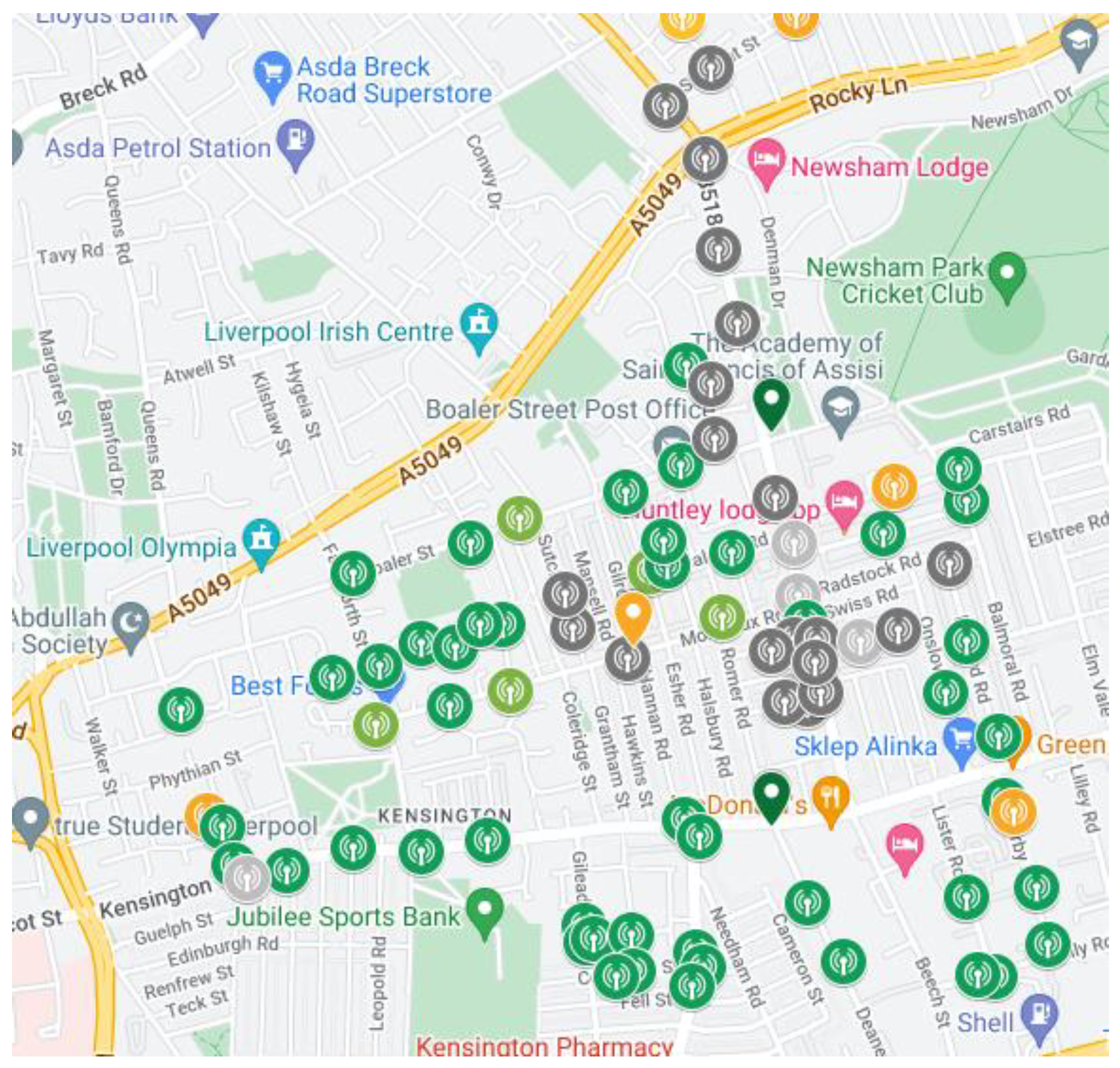
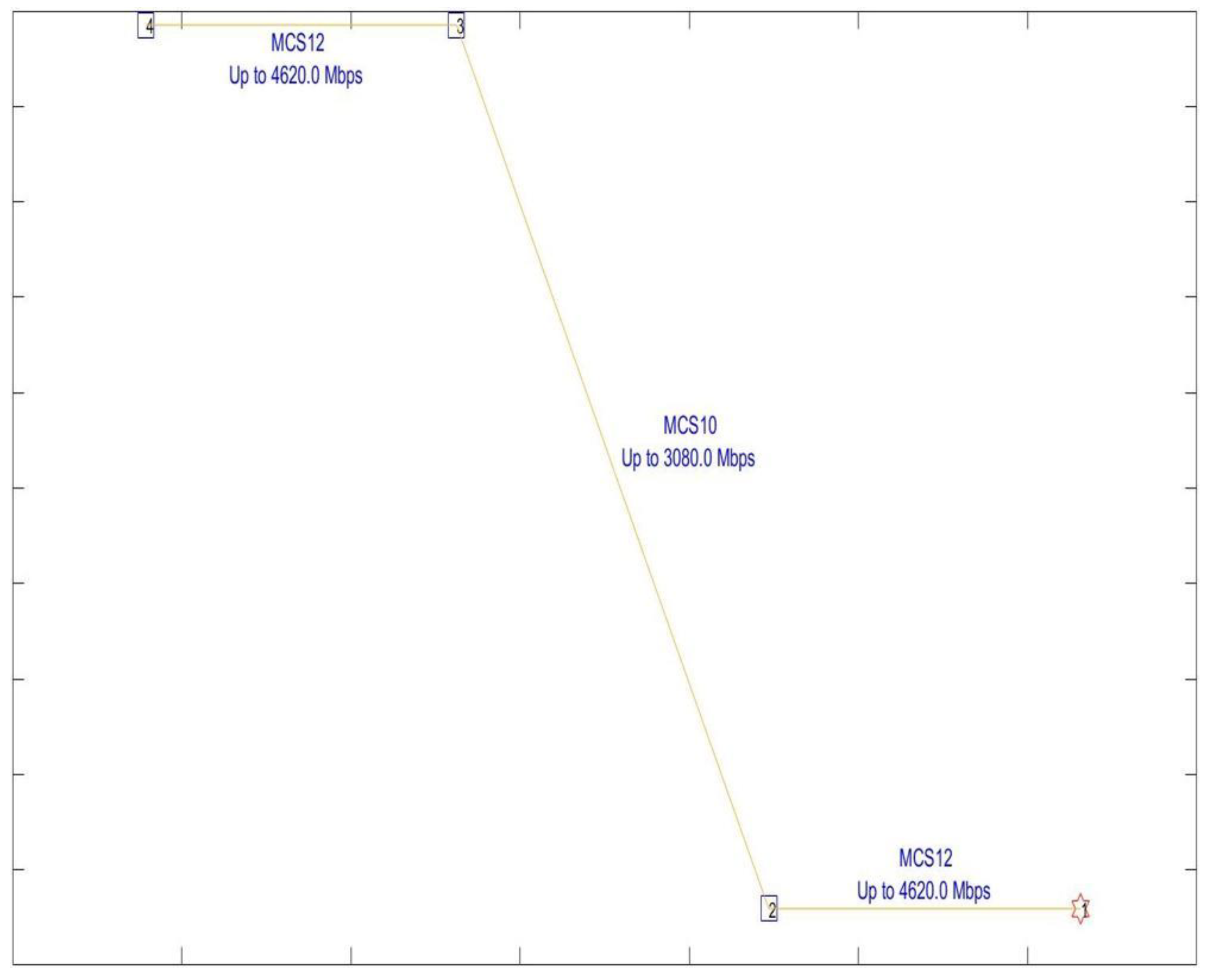
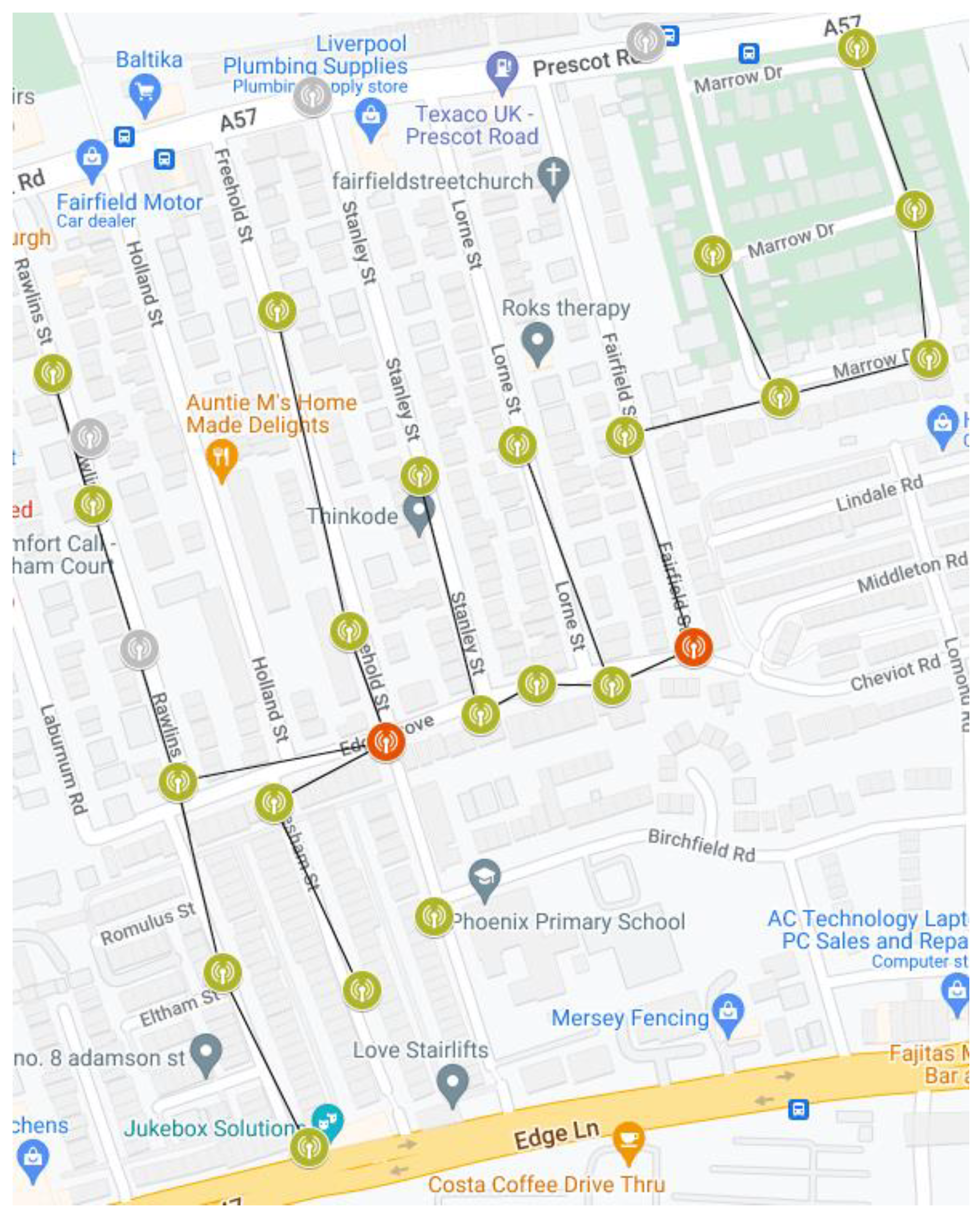


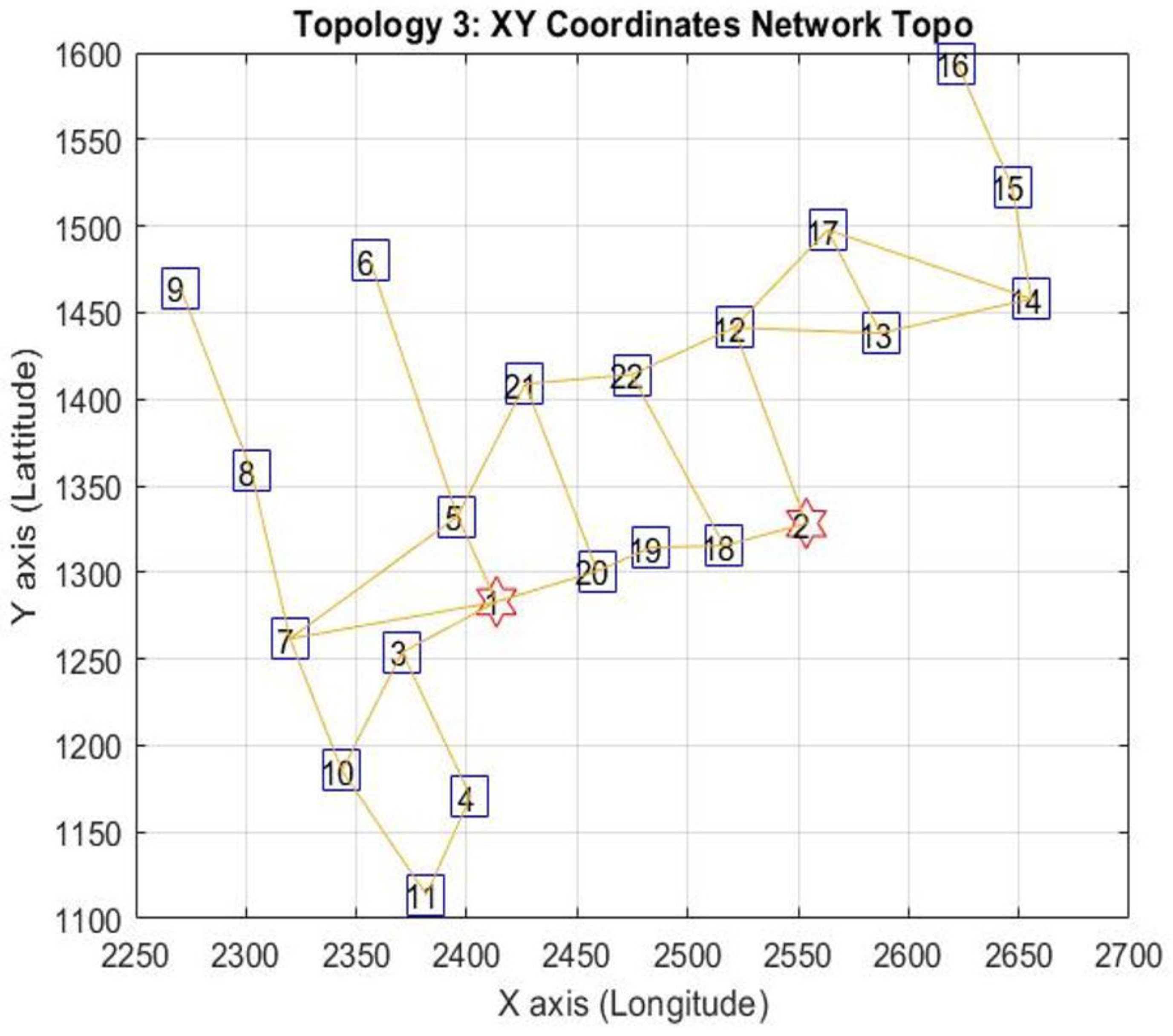


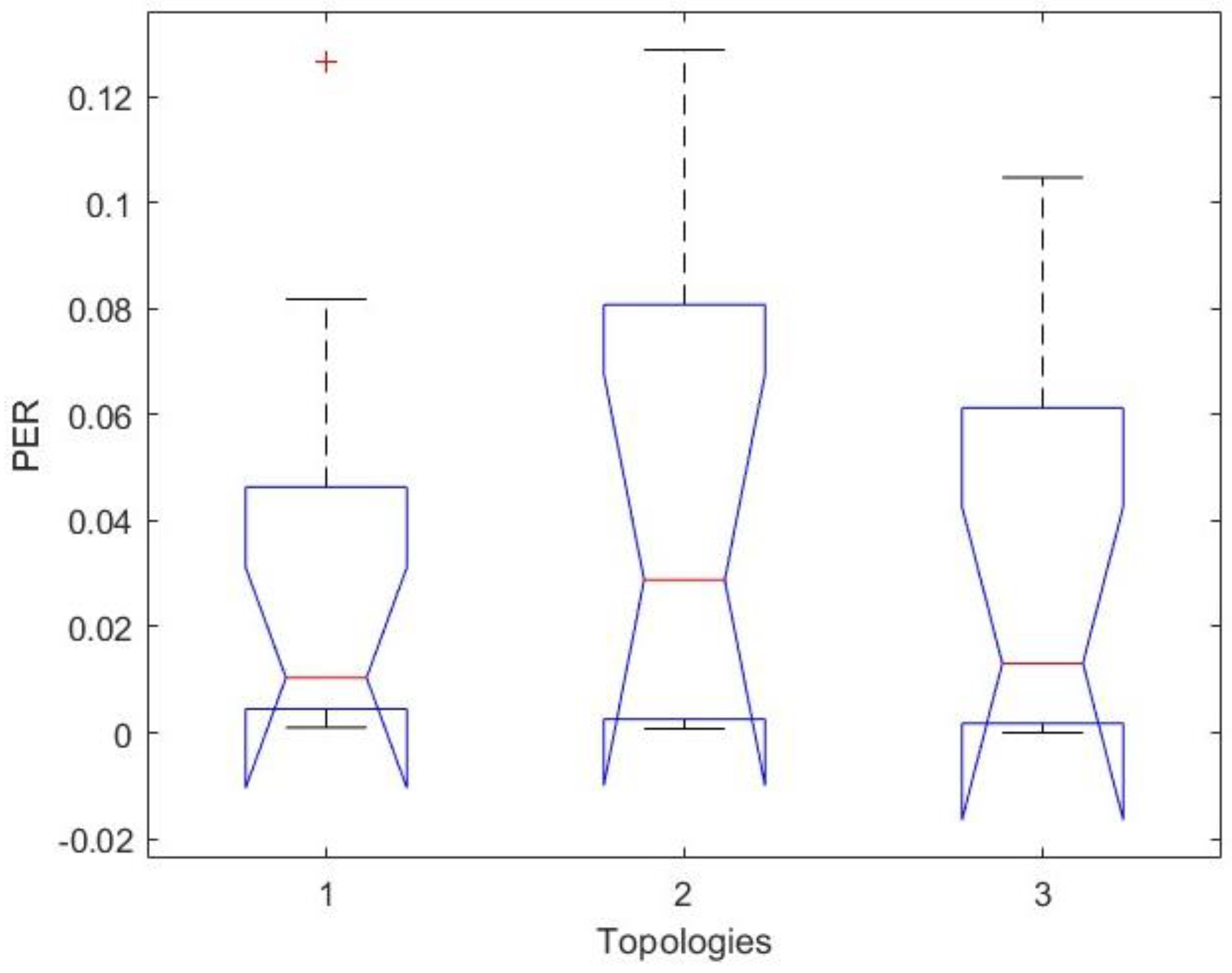
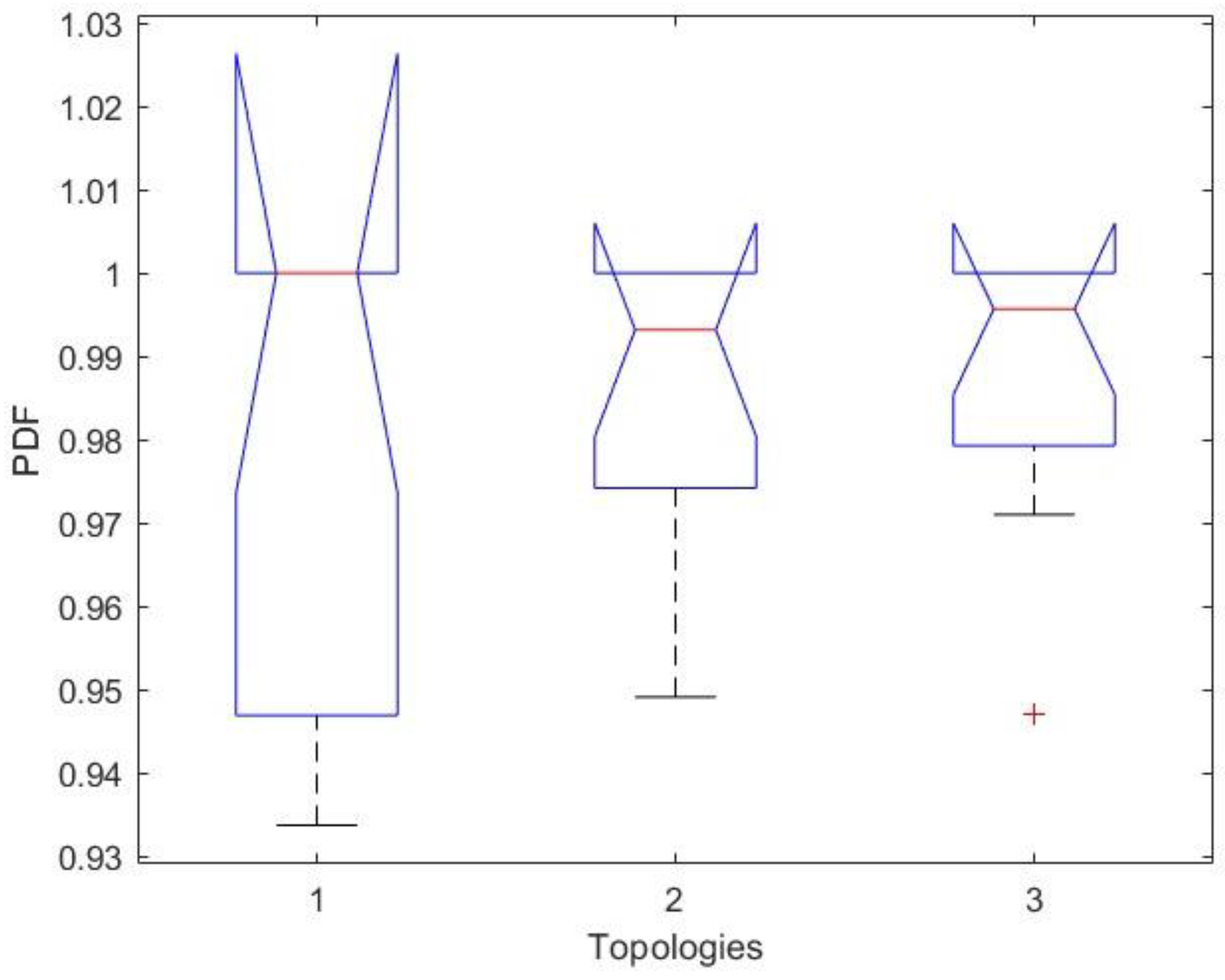
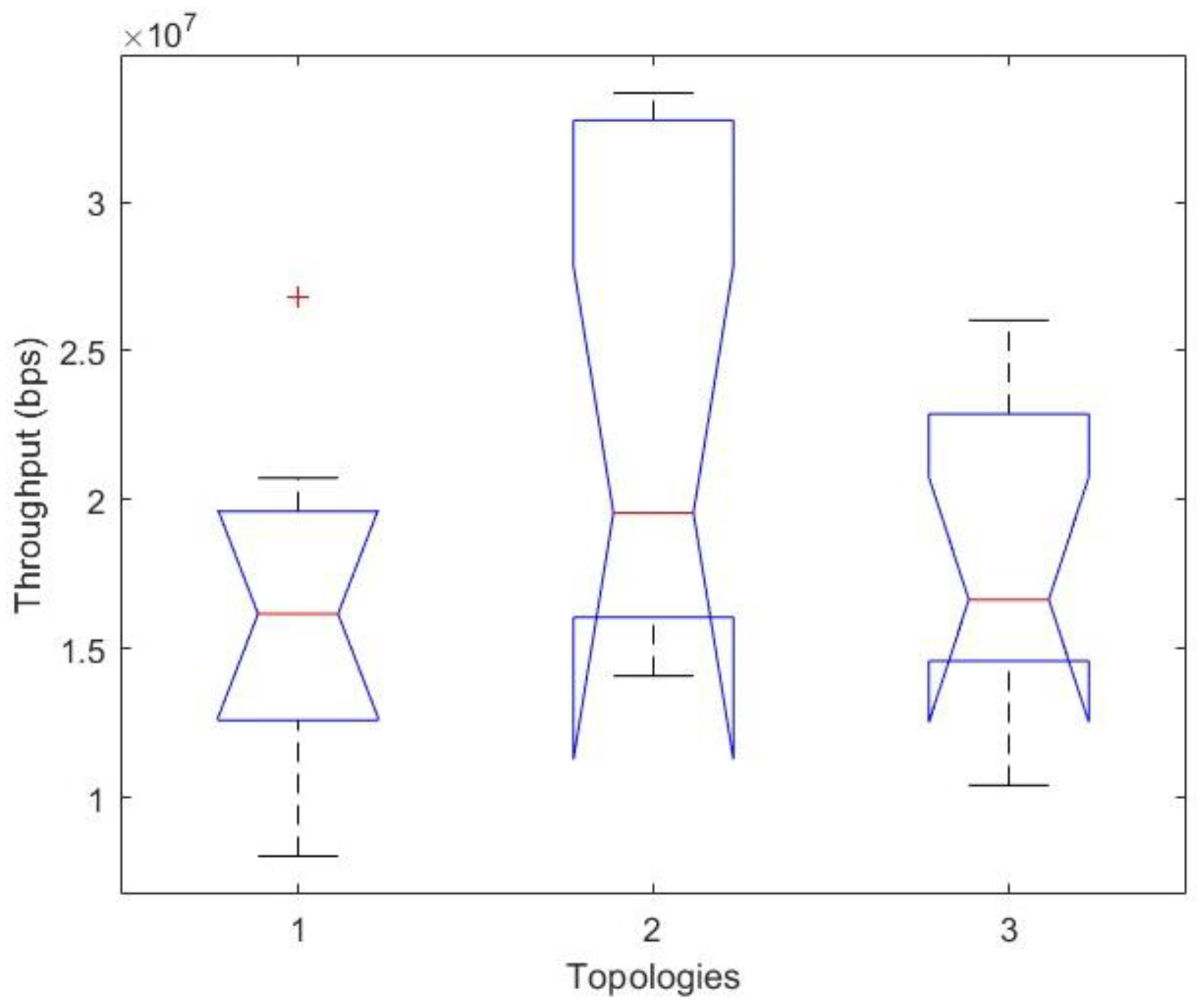
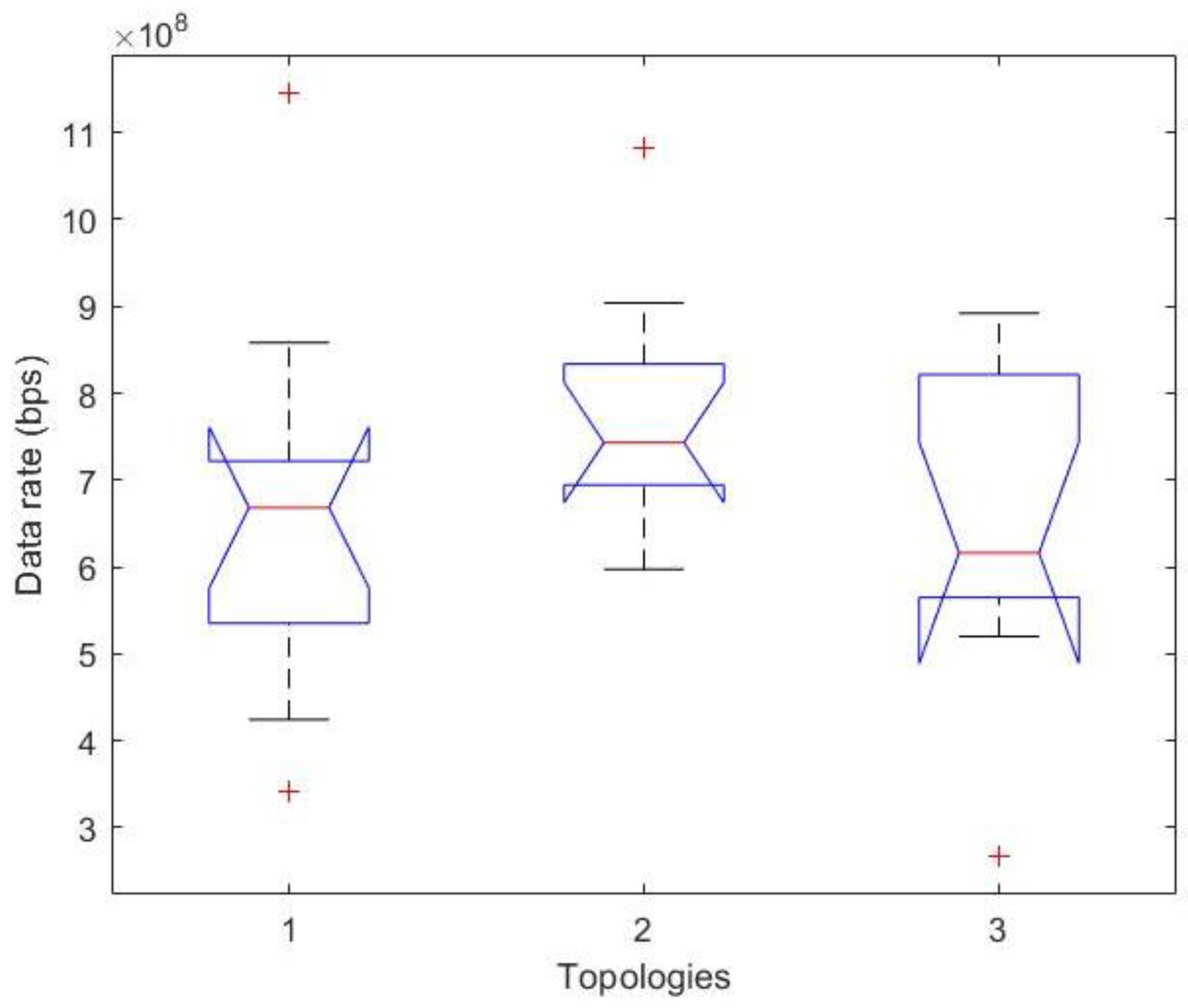
| T | Latency (ms) | PER | Throughput (bps) | Data Rate (Bytes per Sec) | ||
|---|---|---|---|---|---|---|
| 1 | M | 0.2302 | 0.0104 | 1.0000 | 16,167,000 | 83,538,000 |
| C | 74% | 108% | 0% | 64% | 55% | |
| 2 | M | 0.1930 | 0.0289 | 0.9932 | 19,562,500 | 92,896,000 |
| C | 79% | 144% | 23% | 107% | 55% | |
| 3 | M | 0.1913 | 0.0131 | 0.9957 | 16,643,500 | 77,029,000 |
| C | 23% | 138% | 13% | 73% | 41% |
Disclaimer/Publisher’s Note: The statements, opinions and data contained in all publications are solely those of the individual author(s) and contributor(s) and not of MDPI and/or the editor(s). MDPI and/or the editor(s) disclaim responsibility for any injury to people or property resulting from any ideas, methods, instructions or products referred to in the content. |
© 2023 by the authors. Licensee MDPI, Basel, Switzerland. This article is an open access article distributed under the terms and conditions of the Creative Commons Attribution (CC BY) license (https://creativecommons.org/licenses/by/4.0/).
Share and Cite
Gheyas, I.; Raschella, A.; Mackay, M. Optimal Meshing Degree Performance Analysis in a mmWave FWA 5G Network Deployment. Future Internet 2023, 15, 218. https://doi.org/10.3390/fi15060218
Gheyas I, Raschella A, Mackay M. Optimal Meshing Degree Performance Analysis in a mmWave FWA 5G Network Deployment. Future Internet. 2023; 15(6):218. https://doi.org/10.3390/fi15060218
Chicago/Turabian StyleGheyas, Iffat, Alessandro Raschella, and Michael Mackay. 2023. "Optimal Meshing Degree Performance Analysis in a mmWave FWA 5G Network Deployment" Future Internet 15, no. 6: 218. https://doi.org/10.3390/fi15060218
APA StyleGheyas, I., Raschella, A., & Mackay, M. (2023). Optimal Meshing Degree Performance Analysis in a mmWave FWA 5G Network Deployment. Future Internet, 15(6), 218. https://doi.org/10.3390/fi15060218






